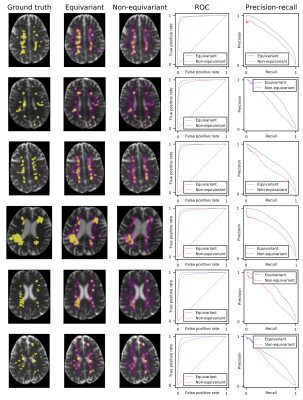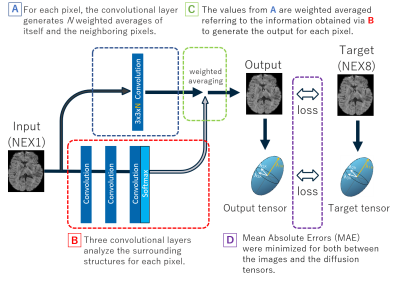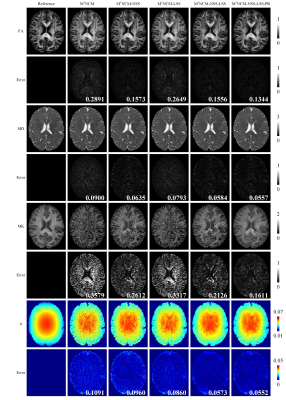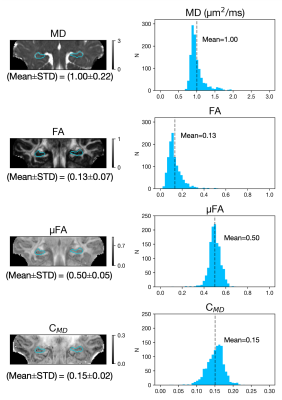Digital Posters
Diffusion: Encoding, Estimation & Machine Learning
ISMRM & SMRT Annual Meeting • 15-20 May 2021

| Concurrent 3 | 19:00 - 20:00 |
2437. |
Quantification of multiple diffusion metrics from asymmetric balanced SSFP frequency profiles using neural networks
Florian Birk1, Felix Glang1, Christoph Birkl2, Klaus Scheffler1,3, and Rahel Heule1,3
1High Field Magnetic Resonance, Max Planck Institute for Biological Cybernetics, Tübingen, Germany, 2Department of Neuroradiology, Medical University of Innsbruck, Innsbruck, Austria, 3Department of Biomedical Magnetic Resonance, University of Tübingen, Tübingen, Germany
Asymmetries in the balanced SSFP frequency profile are known to reflect information about intravoxel tissue microenvironment with strong sensitivity to white matter fiber tract orientation. Phase-cycled bSSFP has demonstrated potential for multi-parametric quantification of relaxation times, static and transmit field inhomogeneity, or conductivity, but has not yet been investigated for diffusion quantification. Therefore, a neural network approach is suggested, which learns a model for voxelwise quantification of diffusion metrics from bSSFP profiles. Not only the feasibility for robust predictions of mean diffusivity (MD) and fractional anisotropy (FA) is shown, but also potential to estimate the principal diffusion eigenvector.
|
|||
2438. |
Rotation-Equivariant Deep Learning for Diffusion MRI
Philip Müller1, Vladimir Golkov1, Valentina Tomassini2, and Daniel Cremers1
1Computer Vision Group, Technical University of Munich, Munich, Germany, 2D’Annunzio University, Chieti–Pescara, Italy Convolutional networks are successful, but have recently been outperformed by new neural networks that are equivariant under rotations and translations. These new networks do not struggle with learning each possible orientation of each image feature separately. So far, they have been proposed for 2D and 3D data. Here we generalize them to 6D diffusion MRI data, ensuring joint equivariance under 3D roto-translations in image space and the matching rotations in q-space, as dictated by the image formation. We validate our method on multiple-sclerosis lesion segmentation. Our proposed neural networks yield better results and require less training data. |
|||
2439 |
Improved image quality with Deep learning based denoising of diffusion MRI data Video Permission Withheld
Radhika Madhavan1, Jaemin Shin2, Nastaren Abad1, Luca Marinelli1, J Kevin DeMarco3, Robert Y Shih3, Vincent B Ho3, Suchandrima Banerjee4, and Thomas K Foo1
1GE Global Research, Niskayuna, NY, United States, 2GE Healthcare, New York, NY, United States, 3Walter Reed National Military Medical Center and Uniformed Services University of the Health Sciences, Bethesda, MD, United States, 4GE Healthcare, Menlo Park, CA, United States
Structure-preserved denoising of MRI images is a critical step in medical image analysis. This is particularly critical in diffusion MRI where higher spatial and angular resolutions required to map tissue microstructure in low SNR (especially at higher b-values) situations, if longer acquisition times are not used. Denoising using deep convolutional neural networks (DCNN) can reduce noise without requiring extensive averaging, enabling shorter scan times and high image quality, especially in the resulting tensor-derived maps. Preliminary results using DCNN based denoising on multi-shell diffusion data demonstrates improved image quality and reduced noise, without compromising on structural integrity and tensor derived metrics.
|
|||
2440. |
Deep learning based denoising for high b-value high resolution diffusion imaging
Seema S Bhat1, Pavan Poojar2, Hanumantharaju M C3, and Sairam Geethanath1,2
1Medical Imaging Research center, Dayananda sagar college of engineering, Bangalore, India, 2Columbia University in the City of New York, Newyork, NY, United States, 3Department of Electronic and Communications, BMS Institute of Technology and Management, Bangalore, India
Deep learning based denoising can improve signal-to-noise ratio in high b-value diffusion imaging. Denoising CNN (DnCNN) model is trained with clean and simulated noisy patches of b=2000 s/mm2 DWI images from Openneuro database. We applied DnCNN to simulated noisy DWI and prospective DWI at b=2000 s/mm2.Unsharp masking used during testing to emphasize medium contrast details. Peak signal-to-noise ratio(>32dB) for simulated noisy DWI and image entropy(>7.17) for prospective DWI obtained after denoising. This denoising can be leveraged to shorten acquisition time by reducing the number of signal averages or increase resolution in through plane by acquiring with smaller slice thickness.
|
|||
2441. |
Microstructural White Matter Segmentation in Mild Traumatic Brain Injury Patients using DTI and a Deep 2D-UNet Ensemble
Brian McCrindle1,2, Nicholas Simard1,2, Ethan Samson2,3, Ethan Danielli 2,3, Thomas E. Doyle1,3,4, and Michael D. Noseworthy1,2,3
1Electrical and Computer Engineering, McMaster University, Hamilton, ON, Canada, 2Imaging Research Center, St. Joseph's Healthcare, Hamilton, ON, Canada, 3School of Biomedical Engineering, McMaster University, Hamilton, ON, Canada, 4Vector Institute, Toronto, ON, Canada
Patients who experience a mild traumatic brain injury often suffer from microstructural white matter damage that even radiologists are unable to detect. By employing diffusion tensor imaging and a deep 2D-UNet ensemble network, we developed an image processing pipeline capable of detecting and segmenting damaged white matter regions. We show that ensemble networks are more reliable compared to any single model over the prediction threshold range under test-time-augmentation.
|
|||
2442. |
Deep learning-based DWI Denoising method that suppressed the "instability" problem
Hayato Nozaki1,2, Yasuhiko Tachibana3, Yujiro Otsuka4, Wataru Uchida1,2, Yuya Saito1, Koji Kamagata1, and Shigeki Aoki1
1Department of Radiology, Graduate School of Medicine, Juntendo University, Tokyo, Japan, 2Graduate School of Human Health Sciences, Tokyo Metropolitan University, Tokyo, Japan, 3Department of Molecular Imaging and Theranostics National Institute of Radiological Sciences National Institutes for Quantum and Radiological Science and Technology, Chiba, Japan, 4Miliman, Tokyo, Japan
Deep learning-based noise reduction technique for DWI contains a risk of outputting values that are greatly deviating from what it should be because of the instability problem of deep learning. The neural network model was designed in this study to suppress this risk which can fix the generated value for each pixel within the range of values of neighboring pixels in the original image. The results of the volunteer study suggested that the proposed method has potential to provide effective denoising beside suppressing the instability risk.
|
|||
2443. |
Accelerating Brain Diffusion Tensor Imaging using Neural Networks: A Comparison of three Neural Networks
Yuhao Yan1,2 and Zheng Chang1,2
1Medical Physics Graduate Program, Duke University, Durham, NC, United States, 2Department of Radiation Oncology, Duke University, Durham, NC, United States
This work focused on accelerating DTI using deep learning methods. Three neural networks including U-net, PD-net and Cascade-net were investigated on reconstructing DTI images, ADC maps and FA maps from Cartesian under-sampled k-space data. The results indicated that Cascade-net out-performed the other two networks, obtaining comparable image quality as compared with the reference reconstructed from full k-space data. In summary, neural networks can be used to accelerate DTI while maintaining image quality.
|
|||
2444. |
Accelerating Diffusion Tensor Imaging of the Rat Brain using Deep Learning
Ali Bilgin1,2,3,4, Loi Do1, Phillip A Martin2, Ethan Lockhart4, Adam S Bernstein1, Chidi Ugonna1, Laurel Dieckhaus1, Courtney Comrie1, Elizabeth B Hutchinson1, Nan-Kuei Chen1, Gene E Alexander5,6, Carol A Barnes5,7,8, and Theodore P Trouard1,3,5
1Biomedical Engineering, University of Arizona, Tucson, AZ, United States, 2Electrical and Computer Engineering, University of Arizona, Tucson, AZ, United States, 3Medical Imaging, University of Arizona, Tucson, AZ, United States, 4Program in Applied Mathematics, University of Arizona, Tucson, AZ, United States, 5Evelyn F. McKnight Brain Institute, University of Arizona, Tucson, AZ, United States, 6Departments of Psychology and Psychiatry, University of Arizona, Tucson, AZ, United States, 7Division of Neural System, Memory & Aging, University of Arizona, Tucson, AZ, United States, 8Departments of Psychology, Neurology and Neuroscience, University of Arizona, Tucson, AZ, United States
The aim of this work is to accelerate analysis of diffusion weighted MRI (dMRI) of the rat brain using deep learning. The proposed approach allows prediction of unacquired diffusion-weighted images (DWIs) from a small set of acquired DWIs. By combining the acquired and predicted DWIs, accurate and reliable diffusion tensor metrics can be obtained with up to ten-fold reduction in scan time.
|
|||
2445. |
Automatic Detection of Nyquist Ghosts in Whole-Body Diffusion Weighted MRI Using Deep Learning
Alistair Lamb1, Anna Barnes2, Stuart A Taylor2, and Hui Zhang3
1Department of Medical Phyics and Biomedical Engineering, University College London, London, United Kingdom, 2Centre for Medical Imaging, University College London, London, United Kingdom, 3Centre for Medical Image Computing, University College London, London, United Kingdom
Despite its potential as an imaging biomarker in assessing tumor response to therapy, use of apparent diffusion coefficient (ADC) as a quantitative endpoint is not routine in clinical practice. One factor that limits the usefulness of ADC is the presence of artifacts in the constituent diffusion-weighted imaging (DWI) data. In this study, we propose a supervised deep-learning approach to detect the presence of Nyquist ghosts in axial DWI slices of the abdomen, achieving a test accuracy of 81.5%. The detection and removal of these artifacts could help improve the reproducibility of quantitative ADC measurements.
|
|||
2446. |
SRDTI: Deep learning-based super-resolution for diffusion tensor MRI
Qiyuan Tian1,2, Ziyu Li3, Qiuyun Fan1,2, Chanon Ngamsombat1, Yuxin Hu4, Congyu Liao1,2, Fuyixue Wang1,2, Kawin Setsompop1,2, Jonathan R Polimeni1,2, Berkin Bilgic1,2, and Susie Y Huang1,2
1Athinoula A. Martinos Center for Biomedical Imaging, Massachusetts General Hospital, Boston, MA, United States, 2Harvard Medical School, Boston, MA, United States, 3Department of Biomedical Engineering, Tsinghua University, Beijing, China, 4Department of Electrical Engineering, Stanford University, Stanford, CA, United States
High-resolution diffusion tensor imaging (DTI) is beneficial for probing tissue microstructure in fine neuroanatomical structures, but long scan times and limited signal-to-noise ratio pose significant barriers to acquiring DTI at sub-millimeter resolution. To address this challenge, we propose a deep learning-based super-resolution method entitled “SRDTI” to synthesize high-resolution diffusion-weighted images (DWIs) from low-resolution DWIs. SRDTI employs a deep convolutional neural network (CNN), residual learning and multi-contrast imaging, and generates high-quality results with rich textural details and microstructural information, which are more similar to high-resolution ground truth than those from trilinear and cubic spline interpolation.
|
|||
2447. |
Inferring Diffusion Tensors on Unregistered Cardiac DWI Using a Residual CNN and Implicitly Modelled Data Prior
Jonathan Weine1, Robbert J. H. van Gorkum1, Christian T. Stoeck1, Valery Vishnevskiy1, Thomas Joyce1, and Sebastian Kozerke1
1Institute for Biomedical Engineering, University and ETH Zurich, Zürich, Switzerland
Cardiac DTI provides invaluable information about the state of myocardial microstructure. Motion and systematic signal variations of the imaging process influence the tensor inference. Image registration prior to tensor fitting with an LSQ estimator is the common data processing approach. The feasibility of training a neural network with simulated data modelling tensors and slice misalignment due to free breathing for inference of diffusion tensors from free-breathing in vivo data is investigated. Evaluation on simulated test data demonstrates feasibility of the training process. Application to in vivo data shows promising results of the CNN especially at myocardial borders.
|
|||
2448. |
Learning the relationship between human brain tissue microstructure and diffusion MRI data
Emmanuelle Weber1, Christoph Leuze1, Daniel A. N. Barbosa1, Gustavo Chau Loo Kung1, Kalanit Grill-Spector1, and Jennifer A. McNab1
1Stanford, Stanford, CA, United States
We demonstrate the feasibility of machine learning direct prediction of tissue microstructure from raw diffusion MRI data. We test the approach by attempting to predict the main fiber orientation as this metric is well-understood and easily extracted using a diffusion tensor model. We present results on both simulated data and a matched dMRI-3D histology dataset.
|
|||
2449. |
Patch-CNN-DTI: Data-efficient high-fidelity tensor recovery from 6 direction diffusion weighted imaging.
Tobias Goodwin-Allcock1, Ting Gong1, Robert Gray2, Parashkev Nachev2, and Hui Zhang1
1Centre for Medical Image Computing (CMIC), UCL, London, United Kingdom, 2High-Dimensional Neurology, University College London Queen Square Institute of Neurology, London, United Kingdom
We present Patch-CNN-DTI, a deep-learning method to estimate diffusion tensors (DT) accurately from only 6 diffusion-weighted images. Early voxel-wise deep-learning methods can only estimate scalar measures of DT. Later work shows DT can be estimated using image-wise methods based on convolutional neural networks (CNN), but they require large training cohort. Patch-CNN-DTI can estimate DT with only one training subject, by pooling information from local neighbourhood of a voxel similar to the CNN but at a much smaller scale to minimise training data requirements. Results show it outperforms conventional model fitting with twice the number of diffusion directions.
|
|||
2450. |
Rapid Multi-slice STEAM Diffusion Imaging with a Prepared Gradient Echo Echoplanar Sequence
David C Alsop1,2, Manuel Taso1,2, and Arnaud Guidon3
1Radiology, Beth Israel Deaconess Medical Center, Boston, MA, United States, 2Radiology, Harvard Medical School, Boston, MA, United States, 3Global MR applications and workflow, GE Healthcare, Boston, MA, United States
STEAM diffusion offers longer diffusion times, reduced gradient demands and other advantages for diffusion imaging but has suffered from long acquisition times. We propose a non-selective preparation of a conventional gradient echo echoplanar sequence that enables the rapid acquisition of many slices. Initial application to the brain readily enabled up to 32 slice acquisition within a single TR.
|
|||
2451. |
Multi-band in Diffusion MRI: Can we go too fast?
Arun Venkataraman1, Benjamin Risk2, Deqian Qiu3,4, Jianhui Zhong1,5, and Zhengwu Zhang6
1Physics and Astronomy, University of Rochester, Rochester, NY, United States, 2Biostatistics and Bioinformatics, Emory University, Atlanta, GA, United States, 3Radiology and Imaging Sciences, Emory University School of Medicine, Atlanta, GA, United States, 4Biomedical Engineering, Emory University, Atlanta, GA, United States, 5Imaging Sciences, University of Rochester Medical Center, Rochester, NY, United States, 6Biostatistics and Computational Biology, University of Rochester Medical Center, Rochester, NY, United States
In this study, we sought to better understand the effect of multiband and phase acceleration on diffusion image reconstruction. As part of an on-going study on SMS in dMRI, 10 test-retest scans from 5 young, healthy subjects were scanned. We found that g-factor, reflecting noise amplification, increased with higher acceleration factors, the g-factor was also higher in frontal regions compared to occipital regions. We also found that the DTI fitting performed worse where we saw increased g-factor. Finally, we found that streamlines were stable as a function of acceleration in the occipital areas, but not frontal areas.
|
|||
2452. |
A unified framework for estimating diffusion kurtosis tensors with multiple prior information
Li Guo1,2,3, Lyu Jian2,3, Yingjie Mei4, Mingyong Gao1, Yanqiu Feng2,3, and Xinyuan Zhang2,3,5
1Department of MRI, The First People’s Hospital of Foshan (Affiliated Foshan Hospital of Sun Yat-sen University), Foshan, China, 2School of Biomedical Engineering, Southern Medical University, Guangzhou, China, 3Guangdong Provincial Key Laboratory of Medical Image Processing, Southern Medical University, Guangzhou, China, 4Philips Healthcare, Guangzhou, China, 5Guangdong-Hong Kong-Macao Greater Bay Area Center for Brain Science and Brain-Inspired Intelligence, Guangzhou, China
Accurate tensor estimation for DKI is usually challenged by noise. The noncentral Chi distribution noise would introduce bias in the estimated DKI tensors. Although several noise-corrected models are statistically unbiased, the DKI tensors generated by these estimators have large variances. In addition, severe noise easily causes the estimated kurtosis values outside a physically acceptable range. The goal of this work is to propose a unified framework that integrates multiple prior information including nonlocal structural self-similarity (NSS), local spatial smoothness (LSS), physical relevance (PR) of DKI model, and noise characteristic of magnitude diffusion images for improved DKI tensor estimation.
|
|||
2453. |
Influence of electrocardiogram signal triggering on filter exchange imaging
Julian Rauch1,2, Dominik Ludwig1,2, Frederik B. Laun3, and Tristan A. Kuder1
1Division of Medical Physics in Radiology, German Cancer Research Center (DKFZ), Heidelberg, Germany, 2Faculty of Physics and Astronomy, Heidelberg University, Heidelberg, Germany, 3Institute of Radiology, University Hospital Erlangen, Friedrich-Alexander-Universität Erlangen-Nürnberg (FAU), Erlangen, Germany
Apparent exchange rate (AXR) mapping can be used to non-invasively investigate water exchange between the intra- and extracellular compartment, which might yield insight into cell membrane permeability. To obtain the AXR properly with the filter exchange imaging (FEXI) approach, signal stability is crucial. We show that electrocardiogram (ECG) triggering can lead to a slight improvement of the signal stability for AXR measurements in the human brain. However, pulsation-induced fluctuations are not the main source of signal variations. Thus, it remains questionable if investing additional measurement time in triggering is justified.
|
|||
2454. |
Improved parameter estimation for non-Gaussian IVIM using an unbiased vector non-local means
Lyu Jian1,2, Xinyuan Zhang1,2,3, Yingjie Mei4, and Li Guo1,2,5
1School of Biomedical Engineering, Southern Medical University, Guangzhou, China, 2Guangdong Provincial Key Laboratory of Medical Image Processing, Southern Medical University, Guangzhou, China, 3Guangdong-Hong Kong-Macao Greater Bay Area Center for Brain Science and Brain-Inspired Intelligence, Guangzhou, China, 4Philips Healthcare, Guangzhou, China, 5Department of MRI, The First People’s Hospital of Foshan (Affiliated Foshan Hospital of Sun Yat-sen University), Foshan, China
Non-Gaussian intravoxel incoherent motion (NG-IVIM) has been proposed to simultaneously quantify the perfusion and non-Gaussian diffusion properties in tissues. However, accurate parameter estimation for NG-IVIM is usually challenged by noise. The noncentral χ-distribution noise would introduce bias in the estimated NG-IVIM parameters. In addition, severe noise easily causes the estimated parameter values have large variance. To improve the accuracy and precision of parameter estimation for NG-IVIM, we propose to use an unbiased vector non-local means (UVNLM) filter to denoise and correct the noise bias before NG-IVIM model fitting.
|
|||
2455. |
Evaluation of quantitative MRI parameters reproducibility across a major scanner upgrade: spinal cord diffusion weighted (DW) imaging
Ratthaporn Boonsuth1, Marco Battiston1, Francesco Grussu1,2, Marios Yiannakas1, Torben Schneider3, Rebecca Samson1, Ferran Prados1,4,5, and Claudia A. M. Gandini Wheeler-Kingshott1,6,7
1NMR research Unit, Queen Square MS Centre, Department of Neuroinflammation, UCL Queen Square Institute of Neurology, London, United Kingdom, 2Radiomics Group, Vall d’Hebron Institute of Oncology, Vall d’Hebron Barcelona Hospital Campus, Barcelona, Spain, 3Philips Healthcare, Guildford, Surrey, United Kingdom, 4Centre for Medical Image Computing, Medical Physics and Biomedical Engineering, University College London, London, United Kingdom, 5E-Heath Centre, Universitat Oberta de Catalunya, Barcelona, Spain, 6Department of Brain & Behavioural Sciences, University of Pavia, Pavia, Italy, 7Department of Brain Connectivity Centre Research Department, IRCCS Mondino Foundation, Pavia, Italy
Major MRI scanner upgrades can potentially introduce systematic changes in quantitative MRI metrics and affect reliability and reproducibility of quantitative parameters. Advanced diffusion weighted (DW) imaging methods are a powerful diagnostic and research tool in the brain and in spinal cord, but it is unclear to what extent DW-derived metrics can be affected by upgrades. Here we assess the effect of scanner upgrades on state-of-the-art spinal cord DW techniques. We found that diffusion matrices such as FA, MD and MK remain stable following a major upgrade when measured in the whole spinal cord, white matter, and grey matter areas.
|
|||
2456. |
High-resolution microstructural imaging in the human hippocampus with b-tensor encoding and zoomed imaging
Jiyoon Yoo1, Leevi Kerkelä1, Patrick W. Hales1, Kiran K. Seunarine1, Iulius Dragonu2, Enrico Kaden1, and Christopher A. Clark1
1UCL Great Ormond Street Institute of Child Health, London, United Kingdom, 2Siemens Healthcare Ltd, Frimley, United Kingdom
In this work, our protocol leverages the most recent advances in the b-tensor diffusion encoding, and also uses a zoomed imaging technique, to specifically scan the hippocampus. Our sequence is able to acquire high-resolution images which enable direct delineation of hippocampal structures and allows estimation of advanced diffusion metrics, as well as parameters that can be measured from a standard multi-shell diffusion data set. Therefore, our acquisition can be used as an all-in-one sequence for microstructural imaging of the hippocampus. We also defined a subsampled acquisition protocol that is feasible for a clinical setting.
|
The International Society for Magnetic Resonance in Medicine is accredited by the Accreditation Council for Continuing Medical Education to provide continuing medical education for physicians.